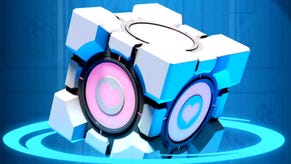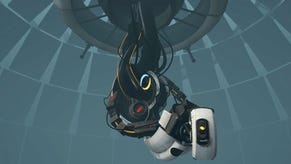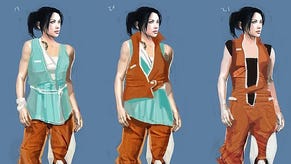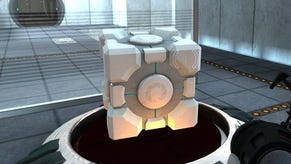Face-Off: Portal 2
Through the looking glass.
| Xbox 360 | PlayStation 3 | |
|---|---|---|
| Disc Size | 4.7GB | 5.7GB |
| Install | 4.7GB (optional) | - |
| Surround Support | Dolby Digital | Dolby Digital, 5.1LPCM, 7.1LPCM |
A wave of incredulity and knowing laughter rippled across the audience of last year's Sony E3 press conference as Valve's Gabe Newell appeared on-stage to announce that Portal 2 was coming to PlayStation 3.
"I've been pretty outspoken in my comments about next-gen consoles," Newell chuckled with a faux sheepishness, "so I'd like to thank Sony for their gracious hospitality and not repeatedly punching me in the face."
The Valve man's expressed opinions on Sony's hardware are a matter of record, with Newell previously describing the system variously as "a total disaster" and "a waste of everybody's time".
In fairness though, it's worth pointing out that the Valve bossman initially wasn't so keen on the Xbox 360 either, lamenting the "train wreck" of Xbox Live and describing the lack of hard drive as something that makes his life "a lot worse" - factors that didn't hold back his company from developing The Orange Box and the Left 4 Dead games, creating multi-million sellers in the process.
During his presentation, Newell went on to make a number of pledges to PS3 owners. Steam would be fully integrated into the PlayStation 3 version, and it wouldn't be appearing within the more enclosed environment of the Xbox 360 ecosystem. Not only that, but he went on to state that PS3 Portal 2 would be the "best console version on any console" - the kind of claim we often hear that is rarely backed up by the quality of the final product.
Well, there's little doubt that in the case of Portal 2, Valve has lived up to its promises. The Xbox 360 version of Portal 2 is a simply sensational game, definitely worthy of the 10/10 Eurogamer review score but the PS3 version offers refinements and value-added extras that make it an even more irresistible buy.
These bonuses stack up not just in terms of features and functionality, but also with regards the visuals too, as our head-to-head movie and this triple-format comparison gallery hopefully demonstrate.
Valve's Source tech doesn't have the look or feel of a state-of-the-art engine, and Portal 2's visuals are defined more by artistic style than by the technology that runs them. Both Xbox 360 and PlayStation 3 versions of the game run at native 720p, with the implementation of anti-aliasing being just about the only major point of differentiation between the two SKUs. And it is pretty major.
Presumably for the purposes of higher performance, the developer hasn't utilised hardware-based AA on either game. Valve appears to have employed morphological anti-aliasing (MLAA) on the PS3, while the Xbox 360 version runs with an edge detect and blur filter which looks very similar indeed to the effect used in the Left 4 Dead games.
Quite how the blur filter works isn't exactly clear but in our shots we see anything from a 1x1 pixel blur to 2x1 through to 3x2 at worst. The angle of the edge also appears to have an impact in determining the extent of the blur; a near vertical edge will be blurred more horizontally while a more horizontal edge will blur more vertically.
Regardless of how it operates, the overall impression is pretty rough, to the point where we'd prefer 0xAA with no blur at all, as in many cases the effect of the "jaggies" actually seems to be amplified by the effect. While the PS3's MLAA isn't a completely artifact-free experience, there's no doubt whatsoever that the style of the artwork works well with the post-process, producing a game that looks significantly more refined than the Xbox 360 version, especially in motion. As you'll see in the comparison gallery or the PC head-to-head later on in the feature, the PS3 release compares favourably with the computer version running with its most computationally expensive anti-aliasing in play.
Most of the other differences we see in our video appear to be down to dynamically flickering light sources, or small, inconsequential bugs. Elements such as general lighting, shadowing, texture quality and filtering appear to be mostly identical between the two console versions, so the overall impression is that the games are very, very close indeed - just with a lack of visual refinement on 360, which varies from scene to scene. That said, a high-quality motion blur seems to be running on certain scenes on both PS3 and PC, and this appears to have been omitted on the Xbox 360 version.
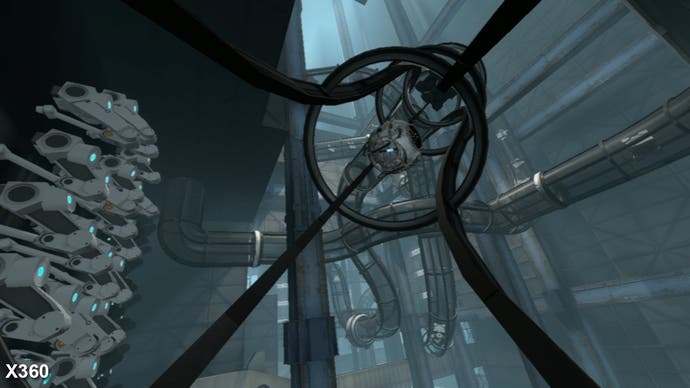

Portal 2 isn't the first Source game to appear on PlayStation 3 of course. In fact, from a certain point of view, it's actually the sixth, factoring in the five games that make up The Orange Box. The difference is that this is the first time we've seen Valve itself get to grips with Sony's hardware directly, with the back catalogue collection having been ported across by a UK team internal to Electronic Arts.
Issues with that particular conversion are infamous and legion, ranging from poor frame-rates to (ironically) a very poor-looking blur filter smearing image detail, dubbed at the time as "the Vaseline effect". The question is just how much of an improvement do we see with the Source engine on PS3 with the benefit of the developer itself at the helm?



